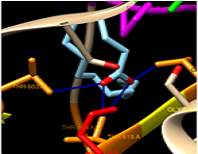Comprehensive In silico Analysis of Antibacterial Compounds in n-Hexane Fraction from Jeruju Leaf (Acanthus ilicifolius)
Abstract
In an emergency, to identify the most promising Hesperidin, Kaempferol-3,4'-di-O-methyl ether (Ermanin); Myricetin-3-glucoside, Peonidine 3-(4’-arabinosylglucoside); Quercetin 3-(2G-rhamnosylrutinoside); and Rhamnetin 3-mannosyl-(1–2)-alloside as a lead compound from Jeruju to develop new drugs from flavonoid analog. The active compound's structure is derived from the PubChem database and improves the stability through ChemDraw v19. The Protein Data Bank website identified the protein macromolecule with PDB code 3VSL. Redocking was performed to ensure validation of 3VSL. The docking method was carried out using the IGEMDOCK software version v2.1. Also, the chimera-1.13.1 program is used to know the interaction profile. The web server pkCSM and Protox II online tool were used to determine the toxicity. 3,7,11,15-tetramethyl-2-hexadecen-1-ol is the juju leaf chemical with the most promise as an antibacterial and the one that shows the maximum binding affinity when taking into account toxicity.
Downloads

Copyright (c) 2024 Arief Kusuma Wardani, Perdana Priya Haresmita, Mahkota Alda, Tischa Vaira

This work is licensed under a Creative Commons Attribution-NonCommercial-NoDerivatives 4.0 International License.
Authors who publish with this journal agree to the following terms:
- Copyright on any article is retained by the author(s).
- The author grants the journal, the right of first publication with the work simultaneously licensed under a Creative Commons Attribution License that allows others to share the work with an acknowledgment of the work’s authorship and initial publication in this journal.
- Authors are able to enter into separate, additional contractual arrangements for the non-exclusive distribution of the journal’s published version of the work (e.g., post it to an institutional repository or publish it in a book), with an acknowledgment of its initial publication in this journal.
- Authors are permitted and encouraged to post their work online (e.g., in institutional repositories or on their website) prior to and during the submission process, as it can lead to productive exchanges, as well as earlier and greater citation of published work.
- The article and any associated published material is distributed under the Creative Commons Attribution-NonCommercial-NoDerivatives 4.0 International License.





_copy1.png)










